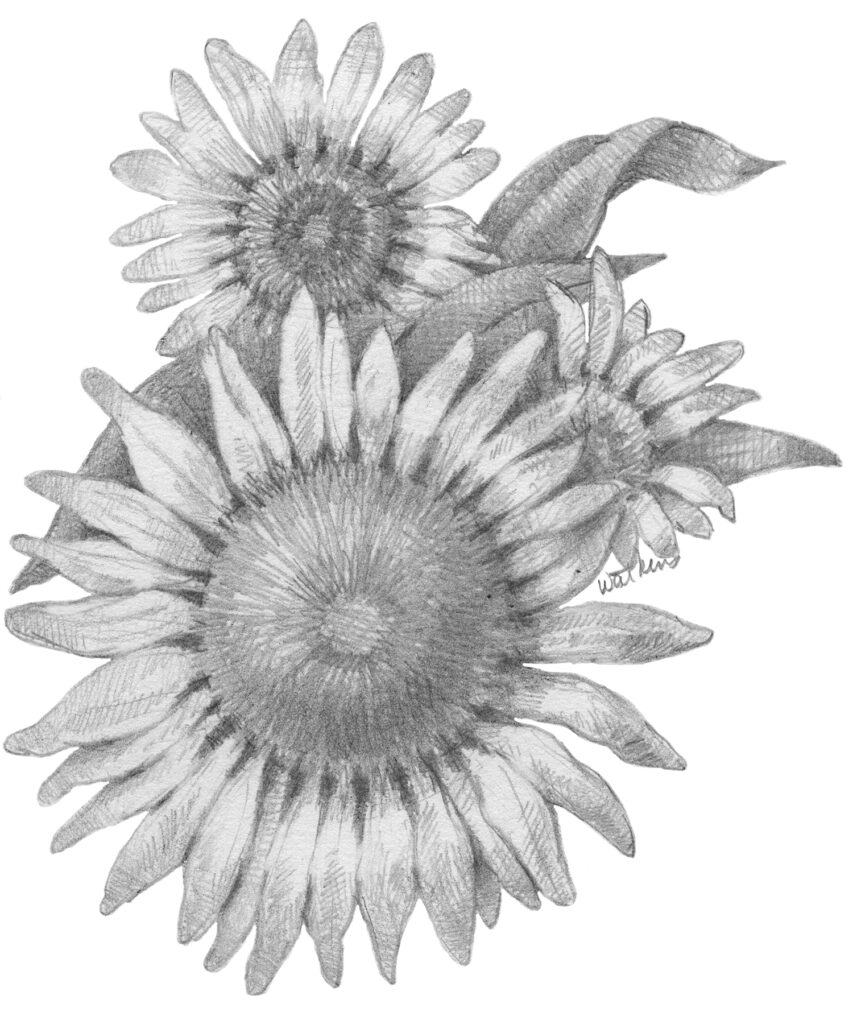September, Think Spring
Text and Illustration by Leslie Watkins

This is the best time of year to get your new gardens started and to improve the gardens you already have. As the days cool down it’s easier to work outside, and there’s plenty to do. Catch the weed seeds now before they get away. Doing a thorough weeding will save time and work next year. Top off the mulch on your beds to retain moisture, prevent heaving and discourage weeds. Mulching your gardens well is one of the best investments you can make to improve the overall health of your plants and cut back on time spent weeding.
Trim back, deadhead and clean up under plants. Removing dead branches, leaves and debris helps with pest control. But find a place to leave debris for the beneficial insects to overwinter away from your gardens. Some of the “good bugs” are centipedes, lacewings, ladybugs, spiders, tachinid flies, praying mantids, wasps, ants and hornets—the list goes on. A great place to learn about beneficial insects is through the New Hampshire Extension Service website. Having a diverse army of little helpers is a lot better and sometimes more effective than spraying with deadly chemicals.
Start collecting leaves, fluff up and turn your compost pile. A compost pile will continue to be active even in winter. The heat produced by the microorganisms, fungi and worms in the center of the pile will keep it going. Insulate the pile well with leaves, clippings and straw. A well made compost pile is moist, airy and contains greens like grass clippings, browns like fallen leaves and kitchen scraps like vegetable trimmings, eggshells, coffee grounds, and staple-free natural teabags. Leave a hole on the top of your pile to add the kitchen scraps and then cover it with leaves. Do not put meat, bones or other animal products into the compost so as not to attract bears and other animals.
Fall is a great time to divide perennials and add new plants. Make sure they are well watered ahead of time. While the soil remains warmer than the air temperatures, roots will continue to grow. Some plants like peonies get established better in the fall, putting on more root growth and allowing them to bloom sooner. Water as needed and mulch well.
As you move around the garden preparing for winter, think about what changes you’d like to make. Stake out areas for new beds and remove sod, turn the soil, add compost and cover with mulch. It will help to kill the grass and weeds, and let the soil settle for spring planting. This method of pre-season cultivation allows the soil microbes to get established ahead of time to help support the healthy growth of plants.
Collect seeds to plant next year and to share with friends. Store dry seeds in jars or in envelopes in a cool dark place. Some seeds need stratification, usually a four- to five-week period of cold temperatures, to germinate. Leave some seed heads for the birds. You’ll enjoy a lot more bird activity and winter interest if you leave seeds that supply the calories they need to survive. Echinacea, rudbeckia, liatris, coreopsis, cosmos, sunflowers and many native shrubs attract and sustain winter birds. The small fruited crabapples, viburnums, dogwoods, choke cherries and hollies attract birds with their fruit.
Collect vegetables for cold storage, freezing or canning. Clear the beds of debris that could provide winter cover for voles. Get the soil ready now for spring planting and you’ll be glad you did. It’s not too late to plant spinach, hardy asian greens, micro-greens, baby kale and fast growing lettuces—especially with row covers. Fall is a great time to start an asparagus bed.
September Chores
- Weed now
- Turn compost
- Collect seeds
- Harvest vegetables
- Plan ahead
- Start new beds
- Plant bulbs
- Divide perennials
- Plant peonies
- Preventive pest control
